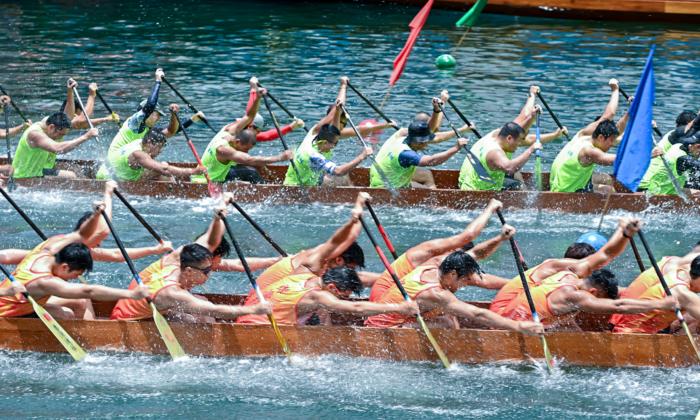168 Teams Compete in the Stanley Races
Despite the hot and stuffy weather, the festive spirit prevailed as people enthusiastically immersed themselves in the atmosphere. Participants could be seen preparing for the competition early in the morning at Stanley Beach, attracting a crowd of spectators who came to watch the races, cheer for their favorite teams, and capture photos with the dragon boats. Some families brought their young children along to partake in the tradition of “Swimming in the path of the dragon.”The Stanley International Dragon Boat Championships drew 168 teams from Hong Kong and abroad, comprising over 5,000 dragon boat racers, predominantly from the finance sector. Contestants warmed up on-site, stretching and getting ready for the competition. They cheered each other on and took group photos to commemorate the event.
Yiu Yiu, a female participant in the first round of the competition, expressed her confidence, mentioning that her teammates had undergone regular training, practicing three times a week. Another men’s team also revealed that they had been practicing three times a week. “We have trained for two months and secured first and fifth positions in the first two games. The third game will be the final, and we are optimistic about achieving good results,” they shared.


Is There Always a Curse on Dragon Boats Bearing the No. 4 Sign?
In addition to the races held at Tai Po Waterfront Park, various other dragon boat races took place throughout Hong Kong. The organizers of the Tai Po race were pleasantly surprised by the overwhelming enthusiasm, with 56 teams and approximately 1,600 rowers participating. The competition consisted of 18 rounds of games scheduled throughout the day.In the Chinese community, there is a belief that the No. 4 sign is associated with a curse. It stems from the fact that the number 4 sounds similar to the word “death” in Chinese. Consequently, many buildings in Hong Kong avoid using the number 4 for floor numbering, such as skipping the 4th floor and going directly from the 3rd to the 5th floor.
Interestingly, the No. 4 dragon boat in Tai Po was not the only one that experienced an unfortunate incident.

During the same day, an incident occurred around noon. In the final of the Sha Tin District “Grape Cup” Dragon Boat Invitation Gala, the No. 3 boat reportedly lost control, crossed its lane, and collided with the neighboring No. 4 boat. As a result, the No. 4 boat capsized, and its occupants fell into the river. They were promptly rescued by the staff on standby aboard nearby ships.
The Alignment of Tuen Ng Festival and the Tropic of Cancer
The Tuen Ng Festival, also known as the Dragon Boat Festival or Duan Yang Festival, falls on the 5th day of the 5th month in the Chinese lunar calendar. Among all the traditional Chinese festivities, it is regarded as one of the three major celebrations, alongside Chinese New Year and the Mid-Autumn Festival. “Duan,” in Dragon Boat Festivals, signifies “first, alpha, beginning.” By the principles of Yin-Yang and the Five Elements, the Dragon Boat Festival represents the critical point of the Yin-Yang transformation, with the Yang Qi reaching its zenith. Ancient wisdom designates this day as the commencement of all actions to prevent plagues. Coinciding with the Western calendar, June 22 marks the direct alignment of the sun with the Tropic of Cancer, symbolizing the transition between winter and summer (conversely in the southern hemisphere).Traditions of the Dragon Boat Festival in Hong Kong Fishing Villages
In the fishing village of Tai O in the west of Lantau Island, Hong Kong, the “Dragon Boat Parade” ceremony hosted by the “Tai O Traditional Dragon Boat Association of Hong Kong” was held for two consecutive days from June 21 to 22. A large-scale dragon boat race called the “Dragon Boat Race in Tai O District to Celebrate Duan Yang” was arranged on the main day of the Dragon Boat Festival.
According to legend, Tai O was plagued by an epidemic over a hundred years ago. In response, the villagers invited dragon boats carrying Buddha statues to parade along the waterways, and miraculously, the epidemic subsided. Since then, dragon boat parades have become a cherished tradition in Tai O. In fact, in 2011, this tradition was recognized and included in the “National Intangible Cultural Heritage” list by UNESCO.

The “Tai O Dragon Boat Water Parade” differs from regular dragon boat races. Traditional dragon boats sail along the waterways of Tai O, accompanied by a divine boat carrying statues of Bodhisattvas. This symbolic procession aims to cleanse the community and offer prayers for safety. As the divine boat approaches a bridge, the bridge is raised to allow smooth passage, signifying respect for the gods.


The “Dragon Boat Parade” ceremony commences on the morning of the fourth day of the fifth month of the lunar calendar (June 21 this year). Dragon boats from Fresh Food Traders and Hop Sam Tong participate in the green plucking ceremony at Yeung Hou Temple. They then visit the four major temples in Tai O, paying homage to the deities and using the boats to transport smaller statues of Bodhisattvas back to the dragon foundation of the fish trader’s office.
On the following day (June 22 this year), the dragon boat from the Boat Rowing Club engages in its own “plucking green” ceremony at Yeung Hou Temple. It proceeds to the four temples to meet the gods. Dragon boats representing the three traditional fishing traders’ guilds gather together, towing the divine boats carrying the statues. They navigate the waterways, scattering note offerings along the route, and pray for favorable weather and safety on water and land.
Onlookers from the shore and huts make sacrifices to the dragon boats, seeking year-round good weather. The three dragon boats compete before finally returning the statues to the temple, marking the ceremony’s conclusion.




